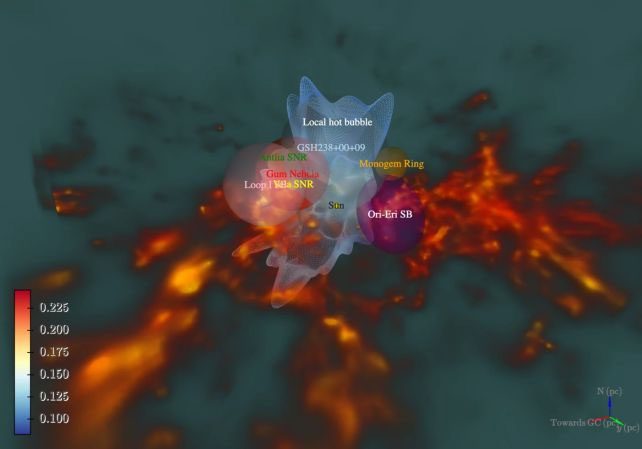Scientists have recently identified an interstellar tunnel connecting the constellation Centaurus to a local hot bubble (LHB), which encompasses Earth.
The Earth and the entire Solar System are contained within an unusual, invisible cosmic structure known as the LHB, a vast region measuring up to 1,000 light-years across, characterized by low density and unusually high temperatures at the edge of the Milky Way galaxy.
A research team has endeavored to map this gigantic LHB bubble and discovered a strange interstellar tunnel.

3D map of the bubble structure that Earth belongs to (gray), marking the position of the Solar System (Sun) – (Image: MAX PLANCK INSTITUTE).
In a study recently published in the journal Astronomy & Astrophysics, the research team led by Dr. Michael Yeung from the Max Planck Institute for Extraterrestrial Physics (Germany) utilized the eROSITA X-ray telescope to explore the LHB.
The researchers divided the eROSITA observations of the X-ray sky into about 2,000 segments and meticulously studied the X-ray light in each segment to create a three-dimensional map of the LHB.
This effort revealed much about this bubble, from how it expands asymmetrically to evidence of uneven temperature distribution, confirming that this structure has been shaped by a series of supernova explosions.
It also indicated that this “bubble” is a rugged structure rather than a spherical one, resembling an ancient creature covered in spines.
Additionally, the 3D map unveiled a surprising fact: this bubble is not closed but has a tunnel structure that connects directly to the constellation Centaurus, standing out against the colder interstellar environment surrounding it.
We still do not know exactly what this tunnel connects to in the region of this constellation.
There are several large objects in that direction, including the Gum Nebula, another neighboring bubble, and several molecular clouds.
It may also provide clues suggesting that the galaxy consists of a network connecting all hot bubbles and tunnels between stars, an idea proposed in 1974 that still lacks substantial evidence.
Scientists continue to research to explain this cosmic tunnel. They hope it may help answer many questions about how galaxies have formed.


















































